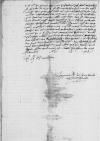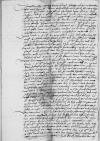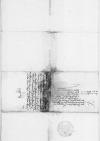Dem durchlauchten, hochgebornenn fursten und herren, herren ⌊Albrechten⌋, von Gots gnaden marggraff zu ⌊Bran[denburg]⌋, in ⌊Preussen⌋, zu ⌊Stettin⌋, ⌊Pom[mern]⌋, [de]r ⌊Cassuben⌋ und ⌊Wenden⌋ [hertzog], burggraff zu ⌊No[remberg]⌋, [furs]t zu ⌊Rugen⌋, [meinem] [guns]tigen, lieben herren und freundt
Disse stunde heutigs tags hab ich bey dissem botenn Ewer Furstlichen Durchlaucht hant und ander ⌊⌋ erhalten, / gelesen / und trewherczigerr meynung mit fleis bewogennn, / und do mit die sache, / die vor handenn, / nicht werde geseumet, / ins korcze zuantwurten vorgenomenn. / Ist ins erst unnotig so vil dancksagen, / dieweil ich Ewer Furstlichen Durchlaucht vorpflicht / und gerne dine. / Amm gutten willenn sol an mir nichts abghen, / so weit sich mein muglicheit erstreckt etc.
Das mir Ewer Furstliche Durchlaucht in gemeltenn eigenn hantschreiben sich nicht besuert, mir so vil guts und freuntlicheit vonn denn durchlauchtenn, hochgebornn Ewer Furstlichen Durchlaucht ⌊furstin⌋ und derr selbtenn bruder / an zu zceigenn, / thue ich mich gen Ewer Furstliche Durchlaucht und sie beydenn uffs hochsts bedanckenn. / Und ist mir fast lieb gewest, das die pomeranczen zu rechterr zceit gekomenn, / derwegenn, so vil ir noch bey mir vorblibenn, / hab dissem Ewer Furstlichen Durchlaucht kamerdiner mitgebennn etc.
Was die vorgenomene handlung, / die mir im andrennn brive Ewer Furstliche Durchlaucht zugestelt, / betrifft, / und nemlich an meinenn bruderlichenn freundt, denn ⌊Nibschicz⌋ etc., hot mir allenthalbenn wolgefallenn. / Und dieweil ich meinenn diner, den ich morgenn aus gen ⌊Krako⌋ wolde schickenn, / noch hie habe, / dem wol zu vortrawenn, / und von mir, / ouch mit demm Nibschicz, / nicht ein mol gen hove gerittenn, / beduncket mich, das er fueglich Ewer Furstliche Durchlaucht schreibenn / mit mag nemenn / und antwurt von den II hernn, / das durch Nibschiczen gefurdert mues werdenn, / mit mag brengenn, welchen II hernn und dem Nibschicz ich in sonderheit wil schreibenn, / die sache in vortraulich anczegenn / und mich uff Ewerr Furstlichen Durchlaucht hochvorsichtlich und zu ⌊koniglicher maiestet⌋, meinem allergnedigsten hernn, / und der ⌊Cronn⌋ Ewer Furstliche Durchlaucht getrewes gemuets wol meynung / zcyhen und referien, / do bey nicht ungemelt lossenn, das zu ehrenn und gunst Ewer Furstliche Durchlaucht gehorig etc. das, / so wir samptlich schribenn, / sich nicht wol teth fuegenn. Wer von den II hern zu forderst geseczt solt werden, / wirt in der ⌊Cron⌋ gehaltenn, / das die bischoffe die erstenn stelle im schreibenn und siczen habenn. / Die nent ouch ⌊konigliche maiestet⌋ in iren briven / hern, / die andrenn woywoden etc. nicht. / Ewer Furstliche Durchlaucht hots fast wolbedocht / an die beyde / disse sache, die wichtig und weit bedenckenn hoth, / zugelangenn zu lossenn. / Es wirt nicht anders, dan Ewer Furstliche Durchlaucht zu gutte und rhumlich / vonn den beydenn heren, / ouch bey ⌊koniglicher maiestet⌋, / angenomenn werdenn etc. Dis korcz schreibenn bit ich Ewer Furstlichen Durchlaucht in gunst von mir zu haltenn. / Ich hab derhalbenn so geeilt, / do mit Ewer Furstliche Durchlaucht widerschreibenn mit den ersten mocht her gelangenn, / das ich meinenn botenn dester eher muge abfertigenn. / Ouch wil ich Ewer Furstlichen Durchlaucht nicht bergen, das ich morgen uber acht tage, / das ist / den 1540-02-27⌊XXVII dits monts1540-02-27⌋, / uff unser ⌊tagfart⌋ gen ⌊Elbinge⌋ mit göttlicher hulff und gnadenn mich von hynnenn uff den weg wil machenn. / Hot mir Ewer Furstliche Durchlaucht was zubefelenn, / darzu bin ich willig und gehorsamm. / Hiemit thue ich mich in Ewer Furstlichen Durchlaucht gunst vortraulich befelenn / unnnd wunsche, / nebenn meinennnn beichtveterlichenn geistlichenn dienstenn, / den durchlauchten, hochgeboren Ewer Furstlichen Durchlaucht ⌊furstin⌋ / mit demm frewlein und bruderr / die gotliche gnad und barmherczigheit / und alles, das zur seele unnd leybe gut und nucz ist. /



